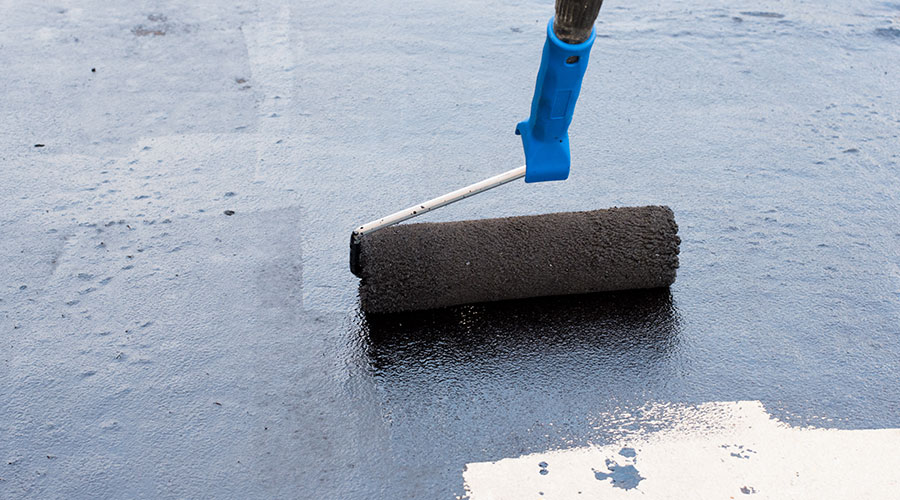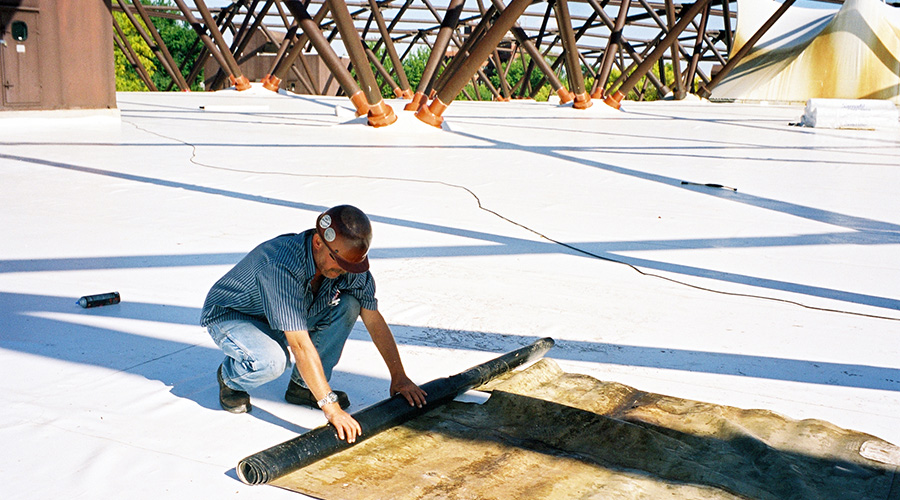in conjunction with the Cool Roof Rating Council
Top-Level Technology
Cool roofs can improve building performance, lower HVAC loads and save energy, all while helping the environment
Increasingly, the environmentally friendly alternative of cool roofs offers institutional and commercial facilities improved building performance, as well as lower overall costs. Promoting sustainability and saving money at the same time is an easy choice for maintenance and engineering managers.
Cool roofing products have been around for years, but because of the efforts of organizations such as the Cool Roof Rating Council (CRRC) and ENERGY STAR®, combined with the incorporation of cool roofs into certification programs like Leadership in Energy and Environmental Design (LEED), LEED for Existing Buildings (LEED-EB), and California’s Title 24 building energy code, the market has expanded significantly
As a result of these developments, managers no longer are thinking of roofs in terms of how well they keep out the elements. They also are considering how well roofs keep out unwanted heat.
Products Evolve
For millennia, people in hot climates have used light-colored building materials to help keep buildings cool. In the United States, the notion that cool roofing was a useful technology picked up speed in the 1980s, when utility rebates became available for cool-roofing materials.
Unfortunately, a lack of standards for the technology led to a variety of disappointing results. Thankfully, much has changed since these failed programs, when the only real requirement was for materials to be light colored and reflective.
Today, building energy codes like California’s Title 24 have set standards for cool-roof materials, and they are enforcing these standards using reliable, accurate radiative property data on roof surfaces collected by organizations such as the CRRC.
Cool roofs are available in virtually every type of roofing material, from modified bitumen and single-ply membranes to spray-on coatings and painted metal roofing.
Cool roofs outperform conventional roofs by doing exactly what their name implies — staying cool, especially during the hot summer months. The primary benefit of this feature is lower energy use and costs as a result of lower air conditioning load.
But cool roofs can offer additional advantages, including:
- reduced HVAC system size, thanks to the smaller peak cooling loads
- increased life of the roof, thanks to decreased thermal stress on materials
- increased comfort for building occupants
- diminished peak demand effects on the power grid
- reduced urban heat island effect, which in turn helps minimize the formation of greenhouse gases and smog.
Radiative Properties
Although cool roofs have been around in some form for quite some time and have received ample exposure in many areas of the United States, their performance details remain somewhat misunderstood. So while selecting a cool roof can be a smart decision, not everyone is clear on what exactly cool entails.
Many elements of a roof’s structure — including insulation and radiant barriers — affect building performance. But while these and other components are undoubtedly important, the phrase “cool roof” refers specifically to the radiative surface properties of the roof.
Radiative properties can be confusing because the two components — solar reflectance and thermal emittance — are not commonly used concepts. Thinking about the problem intuitively, a roof will stay cooler by reflecting the sun’s energy than by absorbing it, as well as by quickly releasing energy it does absorb. Reflectance and emittance quantify these two properties.
Solar reflectance refers to the degree to which a surface reflects the sun’s energy. Thermal emittance refers to the degree to which it releases, or re-radiates, energy it absorbs. Common experience teaches that light-colored surfaces have high reflectance, and many early cool roof rebate programs had this characteristic as their only requirement.
While uncoated shiny metal surfaces are good at reflecting the sun’s energy, they have very low emittance, and because of this low emittance, they become very hot during the day. So a roof that has both high solar reflectance and high thermal emittance is important for improving a building’s energy performance.
Focus on Savings
Understanding the concept behind a cool roof does not describe the kind of actual energy savings managers can expect. Savings vary widely, but the difference in temperature between a cool roof and a regular roof can be significant.
While a dark colored roofing material might be an average temperature of about 60 degrees above the ambient outdoor temperature, a cool roof might be as few as 10 degrees above ambient. A lower temperature means the roof conducts less heat into the building, which translates into a smaller cooling load.
This feature also can mean the building needs a smaller HVAC system, leading to capital cost savings in addition to energy benefits. The exact amount of savings varies depending on climate, roof performance, insulation and other aspects of the building, but cool roofs can yield up to 50 percent savings on cooling load.
A reasonable average savings expectation for a typical application of cool roofing under normal conditions is in the range of 10-30 percent of the cooling energy required. This range might equate to a total electric bill reduction of 3-10 percent. These ranges generally apply to low-rise buildings in regions with significant cooling loads.
For more information on savings calculations and related topics, see the sidebar below.
Northern Exposures
Although the benefits of cool roofing are clear and virtually universal in hot and sunny climates, some managers have voiced concerns regarding the perceived heating penalty that cool roofs incur during winter months in northern states. Typically, this loss is less than generally thought because in winter months, the sun is at a lower angle, is less intense and shines for fewer hours each day.
While this issue might be relevant for a residential building with a low internal heat gain, for commercial buildings, which typically have higher internal gains, summertime air conditioning benefits generally far outweigh any heat gain lost during wintertime.
Further, because reduced air conditioning loads reduce peak grid demand and help prevent urban heat island effects, cool roofs have several key advantages despite the potential minor wintertime losses.
Codes and Ratings
The many benefits of cool roofs are leading managers and engineers to integrate them into building codes and programs. The use of cool roofs is a simple and cost-effective way of meeting California’s Title 24 building code requirements - which take effect in October 2005- for new construction, and it is the only way to comply in non-residential re-roofing situations.
Generally, to qualify as a cool roof low-slope roofing materials must have a rated reflectance of at least 0.70 and rated emissivity of at least 0.75. Title 24 requires that these ratings come from the CRRC. For more on CRRC’s resources and activities, see the accompanying article on this page.
Others jurisdictions outside of California are considering adopting cool-roof standards, and for the nearly 30 states that refer to ASHRAE standards 90.1 and 90.2, their codes already might consider radiative properties. Also, many green building programs, such as the national LEED certification program, credit savings for using cool roofing.
What Lies Ahead
Cool roofing is rapidly becoming more recognized for the benefits it provides. Work and research done by national laboratories, as well as by other institutions such as the Florida Solar Energy Center, have been integrated into programs such as ENERGY STAR®, the CRRC rating system, and LEED, as well as a variety of utility rebate programs nationally.
The efforts of these organizations have helped inform the building design and management community, as well as the public at large, about the benefits of cool roofing. Building managers, maintenance personnel and engineers all will benefit from a better understanding of cool roofing options and from using these systems on their buildings. Better performance and saved energy costs, along with additional environmental benefits, make cool roofs a cool alternative.
Spotlight: 
The Cool Roof Rating Council (CRRC) is a non-profit organization focused on collecting and communicating fair, accurate, and credible radiative performance data of roof surfaces. A clear, fair rating system helps to strengthen markets for roofing products that save energy and reduce a building's impact on the local environment.
CRRC’s approach complements other programs, such as the ENERGY STAR program, which sets minimum performance thresholds for solar reflectance. A growing number of regulators, specifiers, contractors, HVAC engineers and maintenance managers are demanding verified performance of roofing products. Also, code bodies are increasingly choosing to require better radiative performance from roofs.
California has selected the CRRC as the sole supervisory entity to maintain a rating system for compliance with the state’s energy efficiency code, Title 24, which will require cool roofs beginning in October 2005 for low-sloped roofs on commercial buildings.
The CRRC Ratings Program directory currently includes more than 375 products. CRRC charter members include some of the largest and most innovative roofing manufacturers and sellers.
CRRC’s web site, www.coolroofs.org, contains useful information including:
- detailed description of the rating program and documents
- membership information, including a listing of current members
- educational information
- links to utility programs and other programs that promote cool roofs
- CRRC staff contact information.
|
Cool Resources
Web sites for both the U.S. Department of Energy's Oak Ridge National Laboratory and the U.S. Environmental Protection Agency’s ENERGY STAR® program offer cool roof calculators that managers can use to evaluate the savings potential for an individual building based on its location, roof, air conditioning system, and power rates.
For more information about cool roofs, managers can check out the following sites:
|
Terry Lachowicz is a project manager for Energy Solutions and part of the Cool Roof Rating Council’s administrative staff. He has a background in renewable energy, green architecture and energy efficiency.
Related Topics:












